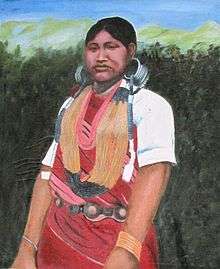Hill Miri people

Hill miri (originally Nyishi , hill miri was the term given by the Britishers )or Nyishi is an indigenous tribe of Arunachal Pradesh in Northeast India.[1] They are spread across six districts viz. Kurung Kumey, Kra Daadi District, East Kameng, Papum Pare, Lower Subansiri and some parts of Upper Subansiri. The Nyishis are the highest populated tribe of Arunachal Pradesh and is estimated close to 300,000,[2] and is one of the largest tribes of Arunachal Pradesh.They speaks Tibeto-Burman language but the exact origin of their language is disputed. Nyishis share common lineage beginning with Ringdo, viz. Dopum, Dodum, Dol/Dolu.
The festivals celebrated with enormous pomp and gaiety are Nyokum, Longte-Yullo and BooriBoot-yullo and are celebrated on 26, 15 and 6 February respectively. The rituals in each of these festivals are carried out by the community priests (Nyub/Nyubu) which includes chanting of hymns and sacrificing animals viz. mithun (Sobe/sebe), goat, chicken, pig etc., and serving of local brew (Opo) to attendees, except in case of longte yullo, no animal sacrifice.
The traditional attires of gents include Lenin cloth wrapped over the body covering the upper portion of the body up to the knees, headgear includes a cap (bopar/bopa/bopia) made of cane which has a strap of bear skin attached anteriorly (sometimes surmounted with hornbill beak at the top). The male carry a machete (orok/oriok) and a knife (rwchik/rwuchuk) shoved inside a bamboo sheath wrapped with animal furs. The ladies wears includes blouse and a long cloth (gale) wrapped around the waist with beautiful piece of art knitted on it. The Nyishi are agriculturalist and primarily grow crops viz. Dagam (rice), Timi (millet), Mekung (cucumber), Takie (ginger) and host of green leafy vegetables. Jhum Cultivation was dominant among the Nyishis but over the course of time have started adopting WRC gradually. They grow millets specially to prepare local brew (Opo), also made from the rice, which is very popular among members of the community and other tribes as well. The brew is served in plenty on occasions like festival, marriage, parties etc.
References